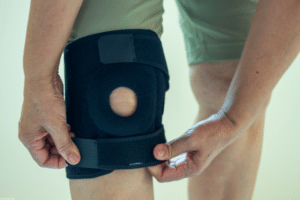What is physiotherapy?
Physiotherapy is a healthcare profession that focuses on restoring, maintaining, and improving patients’ mobility, function, and well-being through physical examination, diagnosis, management, prognosis, patient education, physical intervention, rehabilitation, disease prevention, and health promotion. Physiotherapists work with patients of all ages and with a variety of conditions to develop personalized treatment plans that may include exercises, stretches, manual therapy, and other techniques.
Pain relief
Physiotherapy can help alleviate pain caused by various conditions, such as arthritis, back pain, sports injuries, and post-surgical pain.
Physiotherapists use various techniques to help manage pain and promote healing, including exercise therapy, manual therapy, and modalities such as heat, ice, and electrical stimulation.
Manual therapy is another technique used by physiotherapists to relieve pain. This may include massage, joint mobilization, or manipulation. Manual therapy techniques can help to reduce muscle tension and joint stiffness, which can alleviate pain.
In addition to these techniques, physiotherapists may also provide education on pain management strategies and lifestyle modifications that can help to reduce pain and improve overall health and well-being.
Read more about Physio for Knee pain, Common conditions, and Treatment
Improved mobility and range of motion
Physiotherapy can help improve joint flexibility, increase range of motion, and improve mobility, allowing patients to move with greater ease and comfort.
Physiotherapists use a variety of techniques to help patients improve their mobility and range of motion, including exercise therapy, manual therapy, and stretching.
Exercise therapy is a key component of physiotherapy that can help improve mobility and range of motion. This may include exercises designed to improve strength, flexibility, and endurance. Strengthening exercises can help to build muscle, which can support and protect joints, while flexibility exercises can help to improve joint mobility and range of motion.
Manual therapy is another technique used by physiotherapists to improve mobility and range of motion. This may include massage, joint mobilization, or manipulation. Manual therapy can help to reduce muscle tension and joint stiffness, which can improve mobility and range of motion.
Stretching is also an important aspect of physiotherapy that can help to improve mobility and range of motion. A physiotherapist may develop a personalized stretching program for a patient that targets specific muscle groups or joints. Stretching can help to improve joint flexibility and reduce muscle tension, which can improve overall mobility and range of motion.
In addition to these techniques, physiotherapists may also provide education on posture and body mechanics, which can help to reduce stress on joints and improve overall mobility. Overall, physiotherapy is an effective way to improve mobility and range of motion, and physiotherapists use a variety of techniques to help patients achieve these goals.
Improved strength and endurance
Physiotherapy can help patients improve their strength and endurance through targeted exercises and other interventions.

Physiotherapy is an effective way to improve strength and endurance, and physiotherapists use a variety of techniques to help patients achieve these goals. With a combination of exercise therapy, manual therapy, and education, physiotherapy can help patients improve their physical function and overall quality of life.
Improved balance and coordination
Physiotherapy can help patients improve their balance and coordination, reducing the risk of falls and injuries.
Physiotherapy is an effective way to improve balance and coordination, and physiotherapists use a variety of techniques to help patients achieve these goals. With a combination of exercise therapy, manual therapy, and specialized balance training, physiotherapy can help individuals improve their physical function, reduce their risk of falls, and improve their overall quality of life.
Rehabilitation after injury or surgery
After an injury or surgery, the body may become weak and deconditioned. Physiotherapists use a variety of techniques to help patients rebuild their strength and endurance, including exercise therapy, manual therapy, and specialized rehabilitation programs.

Physiotherapy is an effective way to facilitate rehabilitation after injury or surgery. With a combination of exercise therapy, manual therapy, and specialized rehabilitation programs, physiotherapy can help patients regain strength, mobility, and function, and return to their daily activities as quickly and safely as possible.
Prevention of future injuries
Physiotherapy can help identify and address underlying physical issues that may lead to future injuries or pain, helping to prevent future problems.
Physiotherapists can help identify areas of the body that may be at risk for injury, such as weak muscles, poor posture, or limited range of motion. They can then work with patients to develop a customized plan that addresses these areas and helps to prevent future injuries.
Physiotherapy is an effective way to prevent future injuries. By identifying areas of the body that are at risk for injury, developing customized exercise programs, and providing education on proper body mechanics and posture, physiotherapists can help patients stay healthy and active for years to come.
Management of chronic conditions
Physiotherapy can help patients manage chronic conditions such as arthritis, COPD, and diabetes, improving quality of life and reducing the need for medications or other interventions.

Physiotherapists may also provide education on lifestyle modifications that can help manage chronic conditions. This may include advice on healthy eating, stress management techniques, and strategies for improving sleep.
Improved overall health and well-being
Physiotherapy can help patients improve their overall health and well-being by promoting physical activity, healthy habits, and stress management.
Overall, physiotherapy can help patients improve their physical function, reduce pain, and improve their quality of life.







